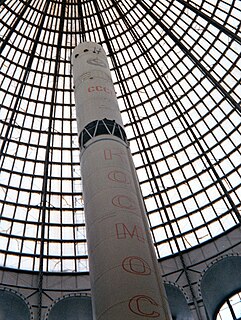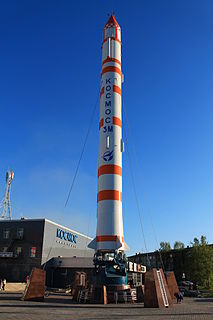
The Soyuz programme is a human spaceflight programme initiated by the Soviet Union in the early 1960s. The Soyuz spacecraft was originally part of a Moon landing project intended to put a Soviet cosmonaut on the Moon. It was the third Soviet human spaceflight programme after the Vostok and Voskhod programmes.
Kosmos is a designation given to many satellites operated by the Soviet Union and subsequently Russia. Kosmos 1, the first spacecraft to be given a Kosmos designation, was launched on 16 March 1962.
The Kosmos-3M is a Russian space launch vehicle, member of the Kosmos. It is a liquid-fueled two-stage rocket, first launched in 1967 and with over 420 successful launches to its name. The Kosmos-3M uses UDMH fuel and AK27I oxidizer to lift roughly 1,400 kg (3,100 lb) of payload into orbit. It differed from the earlier Kosmos-3 in its finer control of the second-stage burn, allowing operators to tune the thrust and even channel it through nozzles that helped orient the rocket for the launching of multiple satellites at one time. PO Polyot has manufactured these launch vehicles in the Russian town of Omsk for decades. It was originally scheduled to be retired from service in 2011; however, in April 2010 the Commander of the Russian Space Forces confirmed that it would be retired by the end of 2010. One further launch, with Kanopus-ST, was planned; however, this was cancelled in late 2012 as the rocket had exceeded its design life while in storage ahead of the launch.

Kosmos 133, Soyuz 7K-OK No.2, was the first uncrewed test flight of the Soyuz spacecraft, and first mission of the Soyuz programme, as part of the Soviet space programme.
Kosmos 419, also known as 3MS No.170 was a failed Soviet spacecraft intended to visit Mars. The spacecraft was launched on 10 May 1971, however due to an upper stage malfunction it failed to depart low Earth orbit.
The Kosmos rockets were a series of Soviet and subsequently Russian rockets, derived from the R-12 and R-14 missiles, the best known of which is the Kosmos-3M, which has made over 440 launches. The Kosmos family contained a number of rockets, both carrier rockets and sounding rockets, for orbital and sub-orbital spaceflight respectively. The first variant, the Kosmos-2I, first flew on 27 October 1961. Over 700 Kosmos rockets have been launched overall.
Kosmos 186 and Kosmos 188 were two uncrewed Soviet Union spacecraft that incorporated a Soyuz programme descent module for landing scientific instruments and test objects.

Kosmos-2I is the designation applied to two Soviet carrier rockets, members of the R-12 Kosmos, which were used to orbit satellites between 1961 and 1977. They were superseded by the R-14 derived Kosmos-3 and Kosmos-3M.
The Kosmos-1 was a Soviet carrier rocket, derived from the R-14 missile, which was used to orbit satellites in 1964 and 1965. It served as an interim, and was quickly replaced by the Kosmos-3. Eight were flown, and all launches occurred from Site 41/15 at the Baikonur Cosmodrome.

The Kosmos-3 was a Soviet carrier rocket, derived from the R-14 missile, which was used to orbit satellites between 1966 and 1968. It was quickly replaced by the modernised Kosmos-3M. Six were flown, four as orbital carrier rockets, and two on sub-orbital flights. All launches occurred from Site 41/15 at the Baikonur Cosmodrome.
Kosmos 6, also known as DS-P1 No.1 as part of the Dnepropetrovsk Sputnik programme and occasionally in the West as Sputnik 16 was a prototype radar target satellite for anti-ballistic missile tests, which was launched by the Soviet Union in 1962.
Dnepropetrovsk Sputnik, also known as DS, was a series of satellites launched by the Soviet Union between 1961 and 1982. DS satellites were used for a number of missions, including technological and scientific research, and radar tracking targets for anti-satellite weapons and anti-ballistic missiles. 185 were launched, using dedicated Kosmos rockets.·
Kosmos 53, also known as DS-A1 No.5 was a technology demonstration satellite which was launched by the Soviet Union in 1965 as part of the Dnepropetrovsk Sputnik programme. Its primary mission was to demonstrate technologies for future Soviet military satellites. It also conducted radiation experiments.
Kosmos 909 was a satellite which was used as a target for tests of anti-satellite weapons. It was launched by the Soviet Union in 1977 as part of the Dnepropetrovsk Sputnik programme, and used as a target for Kosmos 910 and Kosmos 918, as part of the Istrebitel Sputnikov programme.
Kosmos 967 is a satellite which was used as a target for tests of anti-satellite weapons. It was launched by the Soviet Union in 1977 as part of the Dnepropetrovsk Sputnik programme, and used as a target for Kosmos 970 and Kosmos 1009, as part of the Istrebitel Sputnikov programme.
Kosmos 1241 was a target satellite which was used by the Soviet Union in the 1980s for tests of anti-satellite weapons as part of the Istrebitel Sputnikov programme. It was launched in 1981, and was itself part of the Dnepropetrovsk Sputnik programme. It was a target for Kosmos 1243 and Kosmos 1258.
Kosmos Airlines is a Russian airline founded in 1995 which specialises in the delivery of cargo to launch sites.

Kosmos 154, also known as L-1 No.3P, was a Soviet test spacecraft launched from the Baikonur aboard a Proton-K rocket. It was a prototype Soyuz 7K-L1 launched by Proton. It was a crewed precursor to the Zond series.




